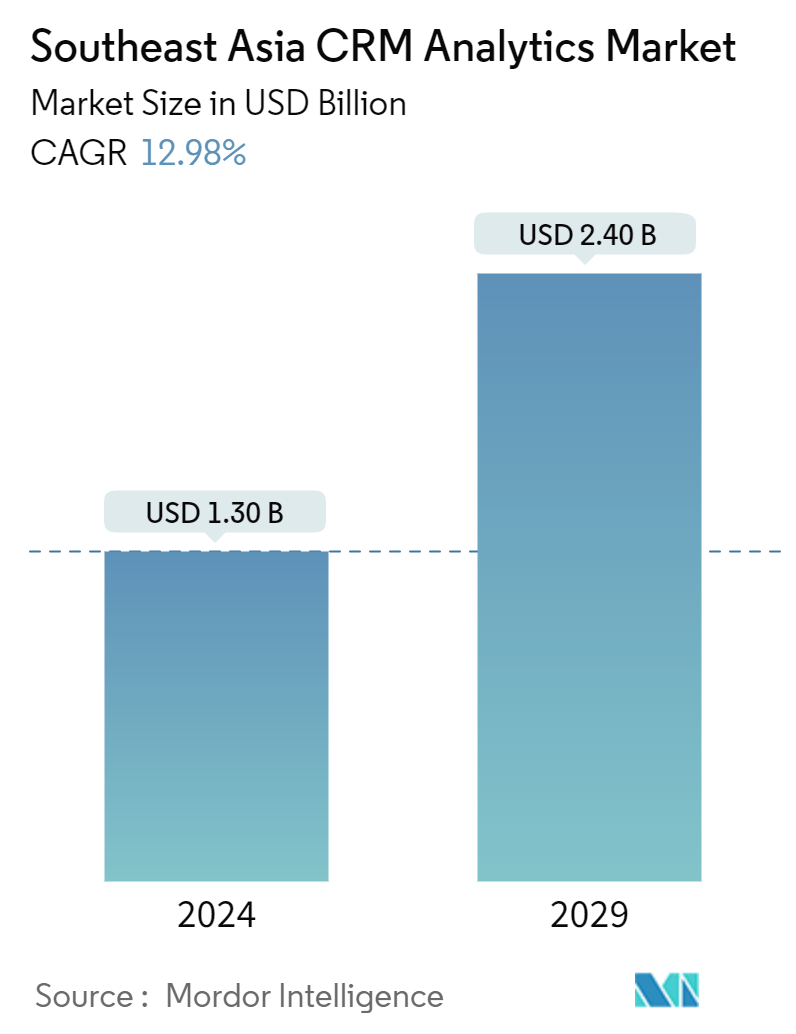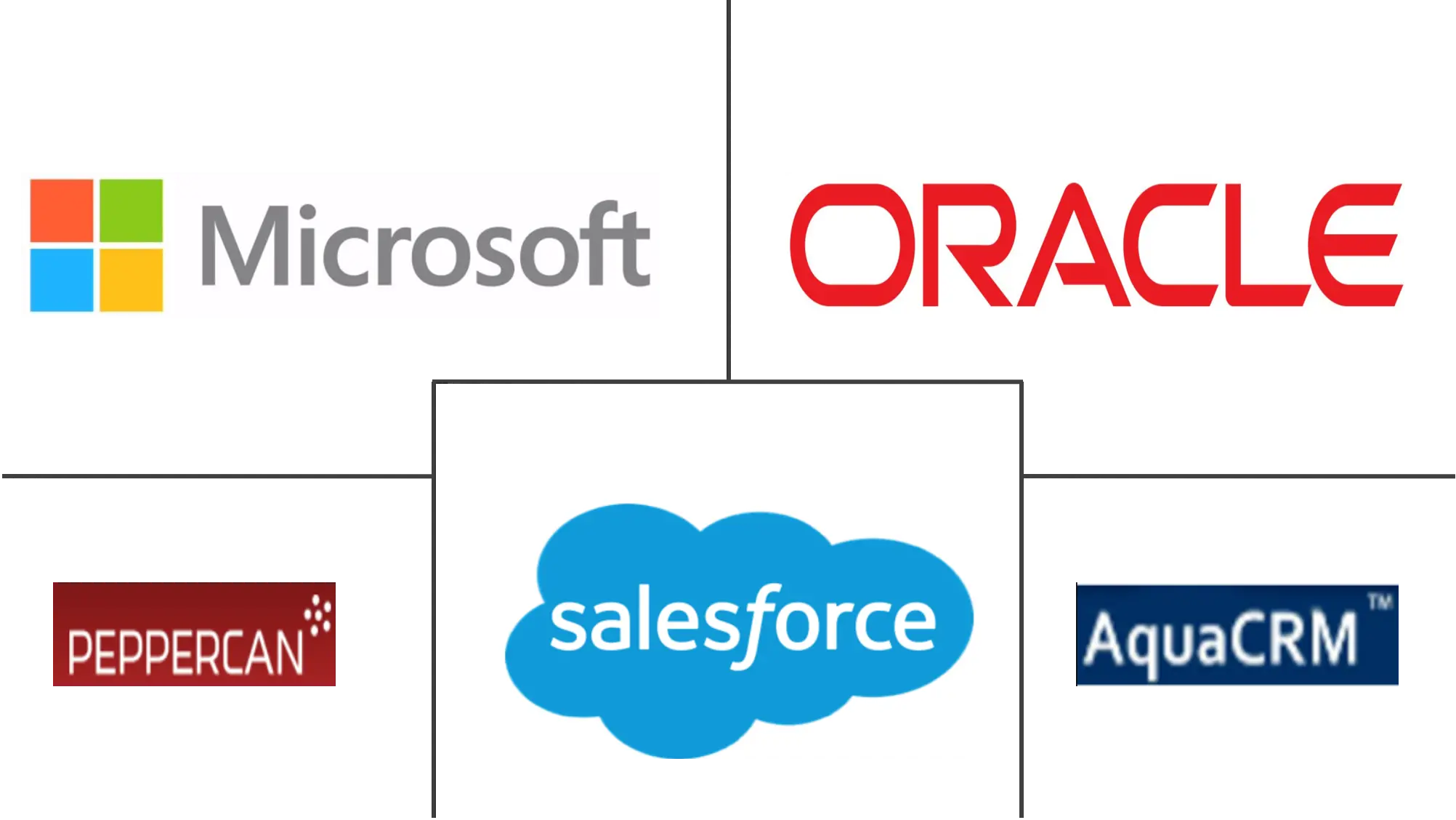Market Size of Southeast Asia CRM Analytics Industry

| Study Period | 2019 - 2029 |
| Base Year For Estimation | 2023 |
| Market Size (2024) | USD 1.30 Billion |
| Market Size (2029) | USD 2.40 Billion |
| CAGR (2024 - 2029) | 12.98 % |
| Market Concentration | Medium |
Major Players
*Disclaimer: Major Players sorted in no particular order |
Southeast Asia CRM Analytics Market Analysis
The Southeast Asia CRM Analytics Market size is estimated at USD 1.30 billion in 2024, and is expected to reach USD 2.40 billion by 2029, growing at a CAGR of 12.98% during the forecast period (2024-2029).
In the Southeast Asian region, there has been an increase in the adoption of modern business software applications by midmarket and enterprise companies. This shift aims to improve business processes and enhance the customer experience. E-commerce, ERP, and Customer Relationship Management (CRM) applications have been particularly prominent in this technology adoption trend.
- The growing availability of data has led to an increase in analytics adoption in Southeast Asia, driving the development of the digital economy. This trend has resulted in a significant rise in marketing expenditure in countries such as Singapore, Indonesia, Thailand, Malaysia, and Vietnam, fueled by increased mobile and internet penetration. The percentage of active social media users in Southeast Asia has also seen substantial growth of 47%, further contributing to the marketing expansion.
- Marketers in Southeast Asian countries are emphasizing real-time marketing, omnichannel delivery and engagement, customer journey mapping, and AI. CRM analytics solutions play a crucial role in helping marketing teams plan, execute, and measure campaigns across various channels. By leveraging customer behavior and choice data, these solutions provide valuable insights that enable strategic decision-making. Additionally, they offer organizations a comprehensive, real-time view of customer insights for informed actions.
- Given the ongoing trend of omnichannel presence, particularly in retail and the BFSI sector, marketers employ multi-channel strategies to achieve diverse objectives such as brand awareness, brand building, lead/sales generation, and customer retention.
- The e-commerce sector is expected to be a significant driver in Southeast Asian countries in the coming years, with global organizations investing in and transforming the region's e-commerce market. The number of online shoppers is steadily increasing each month.
- However, the outbreak of COVID-19 harmed the growth of various industries in the region. Extended lockdowns, export bans, and heightened trade barriers imposed by several countries disrupted economic activities. Malaysia, in particular, was expected to experience a slowdown in economic growth to 3.7% in recent years due to COVID-19. The effects of the outbreak on China's economy may continue to affect Malaysia during the post-pandemic. Additionally, in the post-pandemic, online shopping apps in the region witnessed a gradual decline in conversion rates, coinciding with the rise in COVID-19 cases in Malaysia, Singapore, and Thailand.
Southeast Asia CRM Analytics Industry Segmentation
CRM analytics is an application assessing an organization's customer data to facilitate and streamline business choices. CRM analytical solutions use various applications that help measure the usefulness of customer-related processes and eventually provide customer categorization, such as profitability analysis, event monitoring, what-if scenarios, and predictive modeling. The countries considered under the scope of the Southeast Asian region include Malaysia, Thailand, Indonesia, Singapore, and Vietnam.
The Southeast Asian CRM analytics market is segmented by Type (Sales and Marketing Analytics, Contact Center Analytics, Customer Analytics, and Other Types), Deployment (On-premises, Cloud), End-User (BFSI, Health Care, Retail, Telecom, and IT, Transportation and Logistics, Media, and Entertainment, and Other End-Users), and Country (Malaysia, Singapore, Thailand, Indonesia, Vietnam and Rest of Southeast Asia.
The market sizes and forecasts are provided in terms of value in USD for all the above segments.
| By Type | |
| Sales and Marketing Analytics | |
| Contact Center Analytics | |
| Customer Analytics | |
| Other Types |
| By Deployment | |
| On-premise | |
| Cloud |
| By End-User | |
| BFSI | |
| Health Care | |
| Retail | |
| Telecom and IT | |
| Transportation and Logistics | |
| Media and Entertainment | |
| Other End-Users |
| By Country | |
| Malaysia | |
| Singapore | |
| Thailand | |
| Indonesia | |
| Vietnam |
Southeast Asia CRM Analytics Market Size Summary
The Southeast Asia CRM Analytics market is experiencing significant growth, driven by the increasing adoption of modern business software applications among midmarket and enterprise companies. This trend is particularly evident in the e-commerce, ERP, and CRM sectors, as organizations seek to enhance business processes and improve customer experiences. The proliferation of data has further accelerated the adoption of analytics, contributing to the region's burgeoning digital economy. Countries like Singapore, Indonesia, Thailand, Malaysia, and Vietnam are witnessing a rise in marketing expenditure, fueled by increased mobile and internet penetration and a substantial growth in active social media users. Marketers are focusing on real-time marketing, omnichannel delivery, and AI-driven insights to optimize customer engagement and decision-making.
The digitization trend in Southeast Asia is positively impacting the CRM analytics market, with SaaS-powered solutions offering affordable and scalable options for SMEs and startups. These solutions are crucial for maintaining customer relationships and supporting digital transformation efforts. Singapore stands out as a key market, benefiting from strong government support and advancements in analytics and AI. The retail sector in Singapore is leveraging CRM data to enhance customer experiences and drive sales through personalized marketing strategies. The competitive landscape of the Southeast Asian CRM analytics market includes regional and global players, with companies like Oracle, Salesforce, and Kapture CRM expanding their presence and enhancing their offerings to capture market share and drive profitability.
Southeast Asia CRM Analytics Market Size - Table of Contents
-
1. MARKET DYNAMICS
-
1.1 Market Overview
-
1.2 Industry Value Chain Analysis
-
1.3 Industry Attractiveness - Porter's Five Forces Analysis
-
1.3.1 Bargaining Power of Suppliers
-
1.3.2 Bargaining Power of Consumers
-
1.3.3 Threat of New Entrants
-
1.3.4 Threat of Substitute Products
-
1.3.5 Intensity of Competitive Rivalry
-
-
1.4 Impact of COVID-19 on the Market
-
1.5 Market Drivers
-
1.5.1 Rising use of CRM analytics in Retail industry
-
1.5.2 Rise in Demand for Global Consumer Goods
-
1.5.3 Need for Comprehensive Understanding of Consumer Behavior
-
-
1.6 Market Restraint
-
1.6.1 Data Management and Integration
-
1.6.2 Lack of Awareness on CRM Analytics Market
-
-
-
2. MARKET SEGMENTATION
-
2.1 By Type
-
2.1.1 Sales and Marketing Analytics
-
2.1.2 Contact Center Analytics
-
2.1.3 Customer Analytics
-
2.1.4 Other Types
-
-
2.2 By Deployment
-
2.2.1 On-premise
-
2.2.2 Cloud
-
-
2.3 By End-User
-
2.3.1 BFSI
-
2.3.2 Health Care
-
2.3.3 Retail
-
2.3.4 Telecom and IT
-
2.3.5 Transportation and Logistics
-
2.3.6 Media and Entertainment
-
2.3.7 Other End-Users
-
-
2.4 By Country
-
2.4.1 Malaysia
-
2.4.2 Singapore
-
2.4.3 Thailand
-
2.4.4 Indonesia
-
2.4.5 Vietnam
-
-
Southeast Asia CRM Analytics Market Size FAQs
How big is the South East Asia CRM Analytics Market?
The South East Asia CRM Analytics Market size is expected to reach USD 1.30 billion in 2024 and grow at a CAGR of 12.98% to reach USD 2.40 billion by 2029.
What is the current South East Asia CRM Analytics Market size?
In 2024, the South East Asia CRM Analytics Market size is expected to reach USD 1.30 billion.

